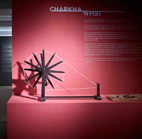If we were to pick a point from India’s history, of design’s inception as a tool for nation-building, it would begin with the humble charkha.
Etymologically, ‘charkha’ originates in Persian, derived from the word charkh — translating into ‘circle’ or ‘wheel’; and charkh-zan, or a ‘spinner’. Early illustrations of the spinning wheel reveal evidence of its use in Baghdad (circa 1200 AD)— it probably came to India and China thereafter.
We could consider the charkha as a starting point for various revolutions — for instance, before the Industrial Revolution in 18th century Europe, people spun yarn and wove cloth and other products at home. After it, the home spinning wheel evolved into industrial usage through inventions like the flying shuttle (1733); the spinning jenny (1746); the spinning mule (1779); and the power loom (1784).
Back home, the Mahatma envisaged it as a tool for social, moral, political and economic regeneration, more importantly as a tool for nation- and identity-building.
Gandhi’s rejection of ‘foreign goods’ was not out of disdain for new technology, but a protest against the exploitative political and economic miasma in which the shipping of cotton to England, and the production of textiles had become embroiled. He felt this homegrown process was a form of generating economic sustainability and self-reliance. It became the trope on which the nation’s historic Swadeshi Movement was fundamentally based on.
In 1921, the charkha became the primary symbol on the flag of the Provisional Government of Free India. The chakra on the current Indian national flag is a derivation of this one.




